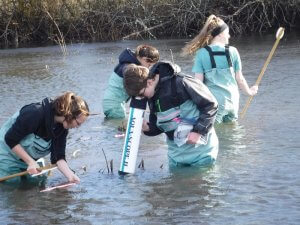Springtime at CASEE

What’s going on in the ponds at CASEE?
Our Freshman and Sophomores are jumping in waders to survey the CASEE amphibian population. Natural Resource students join citizen scientists from all around Washington and Oregon for SWAMP, Southwest Washington Amphibian Monitoring Project. Students search for the egg masses of native frogs and salamanders to identify which species are present and which are absent as well as estimate a population for Northwest Salamanders and Northern Red-legged Frog.
Amphibians are a great indicator of water quality. Their presence indicate that a wetland is functioning as an essential water filter however their absence suggests that toxins are accumulating in the water. Egg mass surveys are a great way to investigate amphibian populations because the masses are usually laid in the open and they don’t run away.
 Students can identify the species that laid the eggs by their number and arrangement as well as several characteristics of the jelly. In addition to surveying the CASEE pond they have traveled to several wetland restoration sites around Clark County to investigate the quality of the habitat.
Students can identify the species that laid the eggs by their number and arrangement as well as several characteristics of the jelly. In addition to surveying the CASEE pond they have traveled to several wetland restoration sites around Clark County to investigate the quality of the habitat.
Spring also means the start of the Wildlife class for CASEE Sophomores. Their first field study is a mark and recapture survey of amphibians in the CASEE ponds. Students trap mobile juvenile and adult amphibians to determine gender, life stage and size. This is the 13th year of the study allowing students to not only research the current population size but also look at variations over time. Stay tuned for student research posters on the CASEE amphibian populations.










 11104 N.E. 149th Street,
11104 N.E. 149th Street,